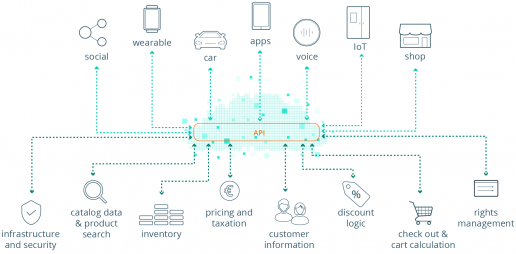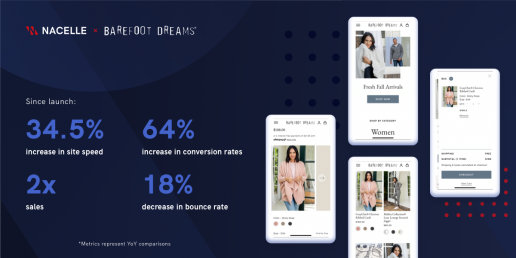Why Fashion Businesses Should Harness the Power of Headless Commerce
ARTICLE BY MUCHANETA KAPFUNDE, FOUNDING EDITOR-IN-CHIEF FASHNERD.COM
In today’s world, it is hard for any industry to ignore the explosion of innovation, let alone the growth of its adoption. Even the fashion industry, which has always been hesitant to invest, started in 2020 to seriously take note when it became apparent that the fashion industry’s overall health was now reliant on its ability to adapt to new ways of doing business. Switching to survival mode, brands and retailers, especially those who have been dealt a tough hand due to the pandemic, started diving into innovations designed to get them back on track. One of these best-in-class technologies is headless commerce.
Born from what RetailDive described as “retailers’ struggle to create an online purchasing experience that was consistent with the slick marketing customers were used to seeing”, headless commerce has been proving to be more than just another buzzword. Although it has been acknowledged by luxury labels like Lancome and Michael Kors, who are using the solution to run their eCommerce stores, the question remains, what is headless commerce?

The Rise of Headless Commerce
For some businesses, it was the enforced disruption of 2020 that brought headless commerce to their attention. If you are hoping to take advantage of what headless commerce can bring to the table, you need first to understand what the solution is. The idea behind Headless is pretty simple. It is the decoupling of the front-end and the back-end of a brand’s e-commerce solution. The front-end is what your customers see when they are interacting with your store. The back-end, which is responsible for all of the functionality, is what the customer never sees.
Now, most e-commerce solutions have their back-end and front-end coupled, which means that any changes requiring a developer to configure code to account for those changes – turning a small project into a big one; and this is when headless commerce comes in. Shaneil Lafayette, Commerce Technology Advocate and Data Analyst, explains: “Headless commerce is a solution that allows you to innovate and add new customer touchpoints without ever having to worry about messing about functionality in expectations”. Adding: “You can add new and personalised commerce experiences to keep up with customer expectations”.
Not an entirely new approach, Nacelle, a company that helps businesses create next-gen web stores by offering headless functionality as a solution, defines headless commerce as an innovation that allows retailers to scale their e-commerce business. More technically, headless commerce is “the decoupling of a website’s front-end from the back-end and implementing an API architecture that enables making fluid changes to the site’s content and user interface elements without affecting the back-end”, according to Algolia, a search-as-a-service platform.

Although brands like Oliver Bonas, Etsy, J.Crew, and ASOS are adopting headless solutions, some brands and retailers are still trying to understand why this ‘future-proof’ package is on the rise. One argument offered by ‘Content And Commerce: The Odd Couple Or The Power Couple?’ authors Stephen Powers and Peter Sheldon is: “It is no longer enough to enable an online catalogue and transactional e-commerce.” A valid point. So taking it one step at a time, to understand why headless is on the rise, I think one needs first to understand the difference between traditional commerce and headless commerce.
Traditional Versus Headless
Before pointing out the difference between traditional or headless, allow me first to say, although headless commerce has its advantages, traditional e-commerce website solutions are always great for those starting or those looking for an easy setup that requires less financial investment. But if you are past that stage and want to take the next step, then headless commerce could be the progressive solution that makes it easier for your business to present experiences and test new strategies.
Let’s start with the front-end. It has been said that when it comes to the front-end, traditional commerce platforms have a reputation for having design constraints that limit developers. This hindrance is usually not experienced in headless commerce. That is not to say that headless commerce doesn’t come with its drawbacks, it does, but with perks that include advantages that enable front-end developers to create, from scratch, a user experience that fits core business needs, the benefits currently outweigh its limitations.
When it comes to customisation, the traditional commerce platform affords limited personalisation, while headless platforms offer developers the opportunity to create their own user experience. By this, I mean that headless commerce is built for customisation, which means that it is a solution that makes it easier for you to rearrange your store or change content as and when you need to.
Ready To Be Free From Traditional Shackles?
Joe Cicman, a Forrester Senior Analyst, once said: “If you rewind the clock to the pre-headless days, you could spend millions of dollars figuring this stuff out for yourself”. The good news is that experts at Amplience have come up with a playbook that offers fashion businesses an opportunity to break down traditional barriers. Supporting headless commerce as an innovative solution, Amplience’s playbook explains the whys, what’s, and how to go headless.
Still wondering if you should get in on the action? Let’s go through some advantages of adopting this modern commerce architecture. It is a solution that gives you the ability to deploy, scale and provide an accurate omnichannel approach. As Harvard Business Review research revealed, this is important because omnichannel customers spend 4% more in-store and 10% more online than single-channel customers. Also that 73% of consumers use more than one channel during their shopping journey.
Another advantage of going down the headless route is the faster speed to market aspect, a must in an industry that thrives on speed and agility. Also, headless commerce can help brands adapt quickly to market changes and implement recent UX changes, like adding new functionality without changing the back-end logic.
Lastly, the most significant advantage has to be headless commerce’s ability to make it possible to build a store that is tailored to a fashion business’ needs. Imagine being able to create an all-in-one-platform that is not a clunky and outdated operation but a seamless system that ticks all your boxes and allows your customers to experience your brand’s overall aesthetic with ease.
Let's Talk Challenges & Whether Headless Is a Best-of-Breed Solution for You
Considering some experts to be a long-overdue upgrade, should you decide to join the headless tribe, you won’t be alone. As I mentioned earlier, Michael Kors shifted to a headless architecture in 2016. The benefits for the American fashion label include streamlining their efforts to engage with mobile users. Also, in 2016 French luxury perfumes and cosmetics house Lancôme transitioned to headless to capitalise on its increased mobile traffic. Following their evolution, Lancôme reported a 36% lift in mobile revenue and an average order value increase of 11%.
Like any emerging innovation, headless commerce comes with limitations. Not a quick solution for every retailer, headless commerce’s initial build costs and times can be relatively high, not to mention the ongoing costs. This is probably why larger organisations have mainly adopted headless commerce with the resources to commit to it. Some smaller businesses have taken a step towards going headless because, in the long run, they are looking at the bigger picture and thinking long term when it comes to their expectations of ROI.
In the end, yes, headless unlocks opportunities, but it is not suitable for everyone. It is a solution that offers excellent benefits if you are looking to bring specific traits to your overall business approach. Still, before you commit, you need to ask yourself, do I want to increase conversions? With mobile-first on the rise, is now the time to optimise my store for mobile shopping experiences? Are modern tools the way forward for my business? If you answered yes to all three questions, then headless could be the solution to help you to scale up and grow faster. Solutions like Mobify, Prismic, Algolia, Magento 2, Shopify Plus and Core DNA could help you make the switch in gradual increments.
So as we propel towards a new retail age in 2021, the fashion industry has started to realise that the road back to “normality” is paved with complex and sometimes intimidating innovation. Joining the dots between digital and physical not only opens the industry to viable solutions that reduce the impact caused by COVID-19, but it is technologies like headless commerce that will help fashion brands and retailers grab a more significant piece of valuable market share that will allow them to thrive post-pandemic.

ABOUT THE AUTHOR
Founding editor-in-chief of FashNerd.com, Muchaneta has worked in the fashion industry for over 14 years. She is currently one of the leading influencers speaking and writing about the merger of fashion with technology and wearable technology.
Muchaneta Kapfunde | editor@fashnerd.com

